This one’s for all of the college kids from Hawaiʻi that have to deal with mainland kitchens claiming to create “Hawaiian” food. In fact, there are many restaurants on the continent that attempt to create their own style of Hawaiian food. They think that by adding ingredients such as pineapple or pulled pork, these dishes somehow evolve into a Hawaiian meal. But that’s far from correct.
For those who did not grow up in Hawaiʻi, it may come as a surprise that Hawaiʻi has its own food. Why? Because we are a real culture. Hawaiians have our own people, our own language, and our own traditions. And stemming from those traditions comes a variety of ʻono dishes that will make any person fall in love with the food of these islands.
So before you even think of getting that “Hawaiian” pizza, take a second to learn more about authentic Hawaiian food. Whether passed down through tradition or making its way on the contemporary Hawaiian food plate, these Hawaiian dishes are the real deal.
Laulau
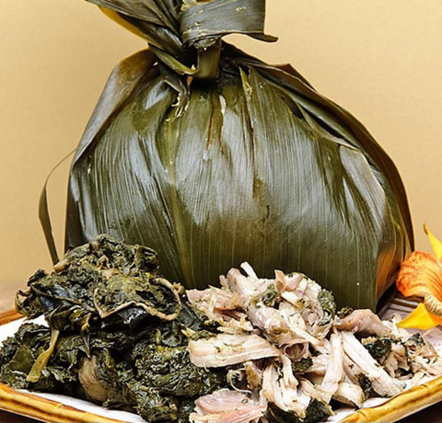
Photo courtesy of halmsenterprises.com
Laulau is a Hawaiian entree that consists of a protein filling that’s wrapped up with kalo, or taro, leaves. Popular choices of filling include chicken, pork, or butterfish. The laulau is then wrapped in ti leaves and steamed. The outcome: soft kalo leaves (think large spinach leaves, but mushier) flavored by the saltiness of your desired meat.
If you’re ever in Hawaiʻi on the island of Oʻahu, I’d recommend picking up a couple laulau from Young’s Fishmarket in Kalihi. They even offer the option of sending someone, or even yourself, a Laulau Care Package.
Kālua Pig
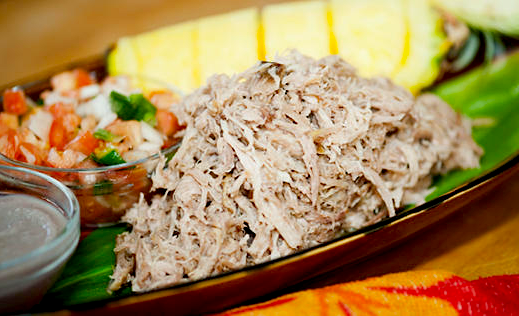
Photo courtesy of foodland.com
Kālua pig, pronounced the same as the liquor called Kahlua, is another favorite Hawaiian entree. The word kālua means to cook in an underground oven, which is called an ʻimu. Kālua pig has a slightly softer texture than shredded pork, but has its own unique smokey and salty flavoring that’s mainly due to its cooking process in the ʻimu.
If by chance you can’t create your own underground oven in your backyard, you can still mimic the flavor by using liquid smoke flavoring and Hawaiian salt.
Lūʻau

Photo courtesy of privatetourshawaii.com
Lūʻau are the young leaves of the kalo plant that are cooked with coconut milk and pieces of chicken (or more famously, squid). The texture is as unique as its flavor: the leaves become so soft, they’re almost soup-like, and the flavor balances the sweetness of the coconut milk, offset by the addition of Hawaiian salt.
You may have noticed that the word lūʻau is the same word that defines a Hawaiian feast or party. This is true, but it should be noted that the term lūʻau was only used to describe a feast from around the mid-nineteenth century and onward. Formally, a Hawaiian party was called a pāʻina or ʻahaʻaina.
Chicken Long Rice
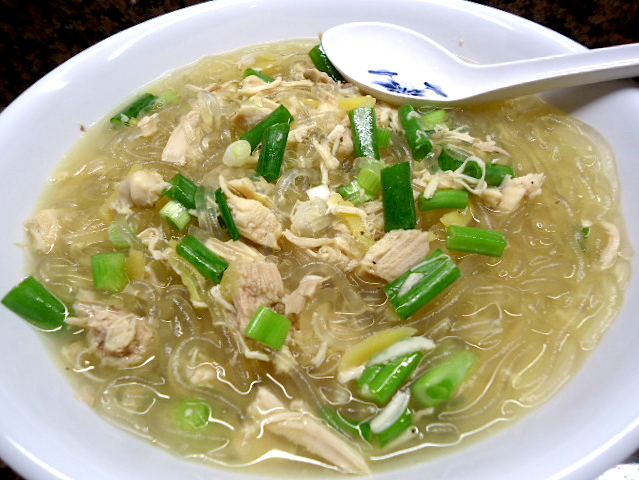
Photo courtesy of mykitcheninthemiddleofthedesert.files.wordpress.com
Chicken long rice is actually a Chinese dish that has been adapted to the tastes of Hawaiʻi over time and eventually found its way onto the modern Hawaiian plate. The “long rice” used is actually bean thread noodles. Chicken long rice combines the flavors of garlic, ginger, and green onion to create a comforting dish that’s best served warm.
Poi
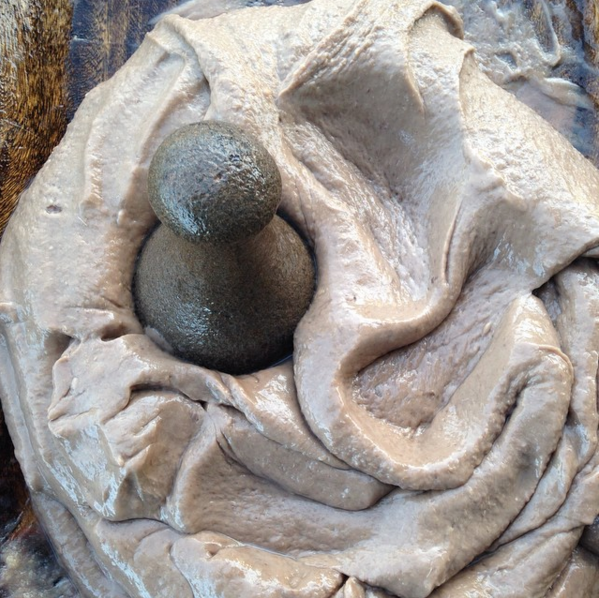
Photo courtesy of @waiaholepoifactory on Instagram
Poi is a mixture of kalo and water, pounded until it becomes a paste-like substance. It has probably garnered the title of being the most bizarre food to come from Hawaiʻi, because there really aren’t any other foods to compare to its near-bland flavor and odd coloring.
However, its significance in Hawaiian culture makes it the most important staple in Hawaiian food. In Hawaiian mythology, it’s believed that kalo is the original ancestor of the Hawaiian people. If you’re still unsure about eating poi, I’d recommend eating it paired with salty Hawaiian foods such as kālua pig, lomi salmon, dried aku, or poke.
Poke
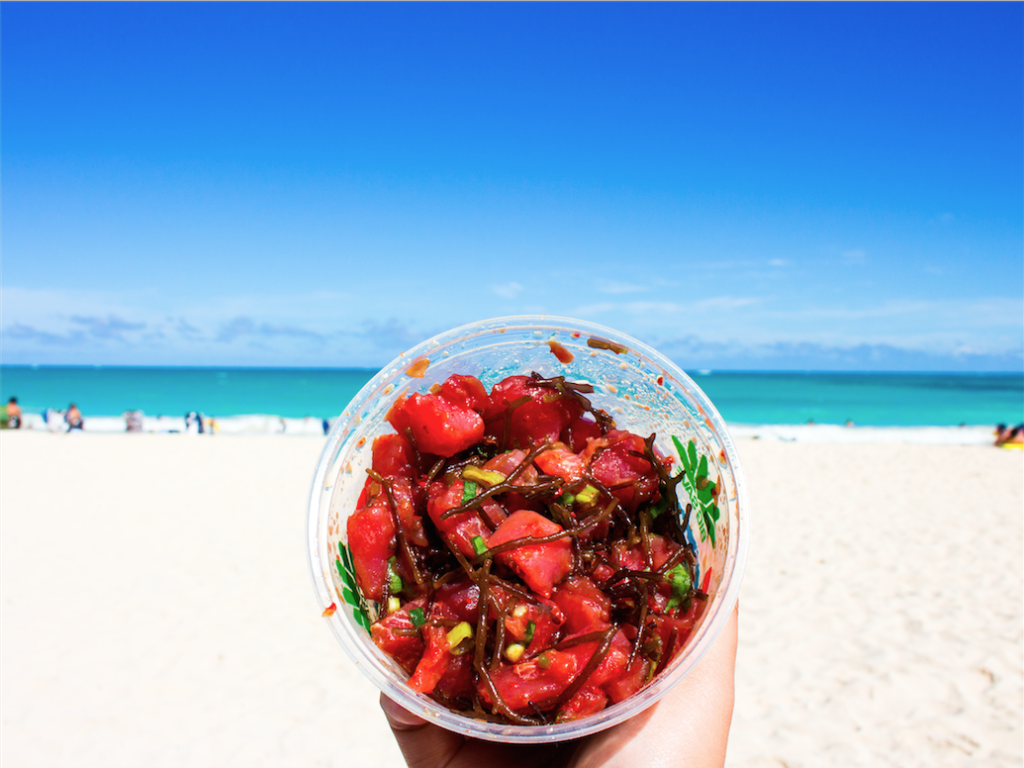
Photo by Cali Kinimaka
Poke (pronounced poh-keh) is the Hawaiian verb meaning to slice into pieces. Most poke will be diced pieces of fish with seasonings such as shoyu (the Japanese term for soy sauce… no one in Hawaiʻi says “soy sauce”), limu (seaweed), Hawaiian salt, and green onion. Other kinds of poke could include tako (octopus), clams, or even tofu.
Poke has such a high demand here in Hawaiʻi that you can find it at most grocery stores, such as Foodland, Times, Safeway, and Whole Foods. These stores will have a seafood section, displaying a variety of poke that you can order at 1/4 or 1/2 pound increments.
Recently, poke has gained the attention of people looking for healthy food alternatives across the nation. But if you want real, fresh, local poke, then you gotta make a trip to the islands. For some reason, it tastes much better if you’re eating it on a bright, sunny day at a sandy beach in Hawaiʻi.
Lomi Salmon
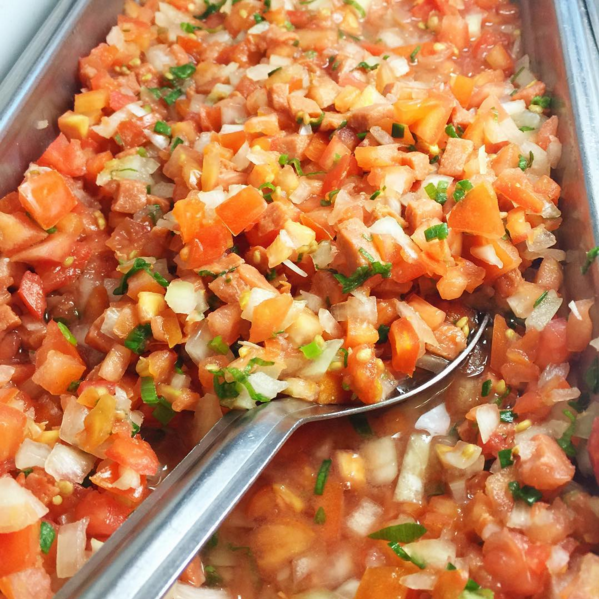
Photo courtesy of @enfuegogrillhawaii on Instagram
One of the best side dishes on the Hawaiian plate, lomi salmon offers the freshest flavor to complement the entrees. Lomi in Hawaiian means to rub or massage, and refers to the preparation of the salmon for this dish. For a basic recipe, salt is massaged into the fish, which is then diced and mixed with fresh tomatoes, onions, and green onions.
Its flavor can be best enjoyed when the dish is chilled. My favorite way of eating lomi salmon is by simply eating it with poi in a cup.
Dried Aku
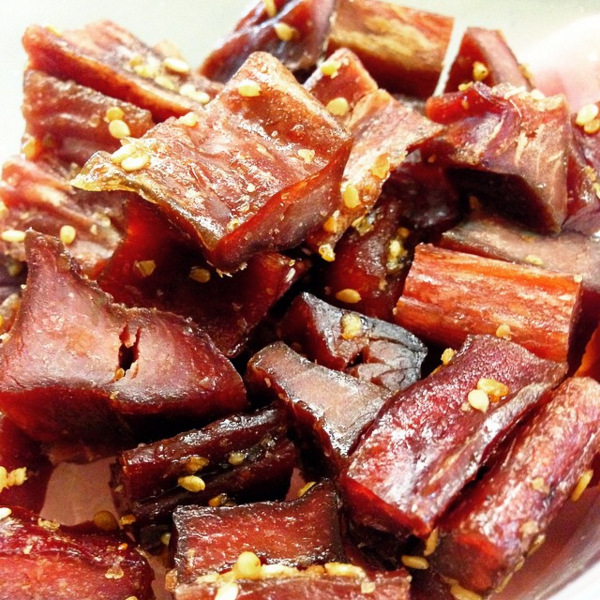
Photo courtesy of @joergalfter on Instagram
There may be some debate as to whether this should be called dried aku or dry aku, similar to how Hawaiʻi locals know to say shave ice instead of shaved ice. But either way, you should let the flavor speak for itself.
Aku in Hawaiian refers to the Skipjack tuna, and as stated in its name, the fish is dried out through a 9+ hour process to create a jerky-like texture. Salty and easy to eat, this dish is another that I’d recommend eating with poi.
Pipikaula
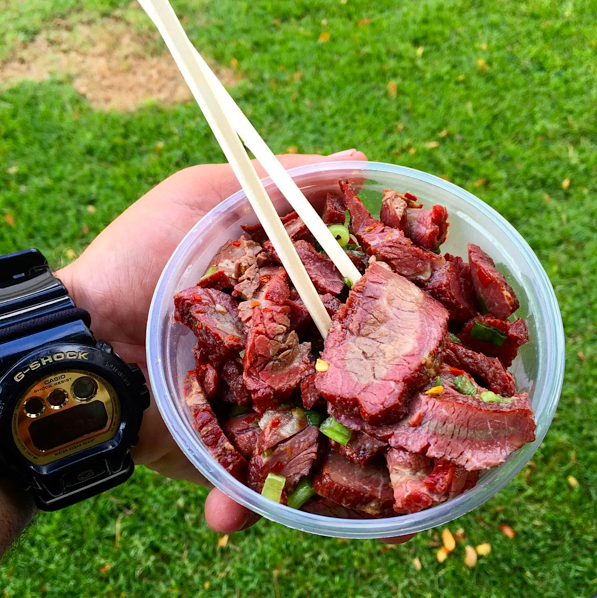
Photo courtesy of @elevenoh1 on Instagram
Going along with the theme of dried meats, this is pipikaula, otherwise known as Hawaiian-style beef jerky. Pipi, or bipi, is the Hawaiian word for beef, and kaula means rope, so essentially it means beef rope.
Pipikaula became a favorite snack for paniolo (Hawaiian cowboys) in the 19th century. Today, it is often offered at parties as pūpū, or appetizers. As skeptical as you may be, this pipi is one of the best pūpū you will ever eat.
ʻUala
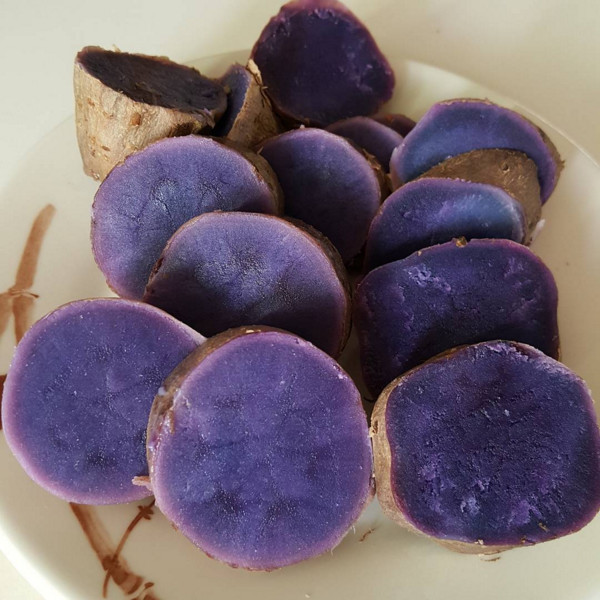
Photo courtesy of @sherimiya on Instagram
ʻUala means sweet potato in Hawaiian, and this beautiful purple sweet potato is actually the Okinawan sweet potato. This particular sweet potato may not have as deep of cultural roots to Hawaiian culture compared to other varieties, but it is still one of the staple sides to a Hawaiian plate. It’s simply steamed, sliced, and enjoyed in its entirety.
The orange sweet potato that is more prevalent in the mainland is not seen here in Hawaiʻi as much as these purple ones. Next time you’re watching the lūʻau scene in Lilo and Stitch, you’ll notice that the mashed sweet potatoes on the plate that Lilo doesn’t finish are orange instead of purple. Not quite right, Disney.
Haupia
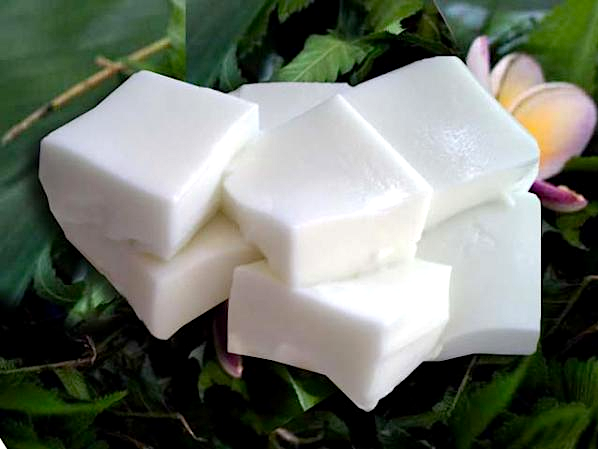
Photo courtesy of shakatime.com
Haupia is a coconut milk-based gelatin dessert, although its texture is somewhere in between jello and pudding. Traditionally, it’s made by mixing coconut milk with pia, or arrowroot, but modern recipes make it with cornstarch instead.
It’s sweet, creamy, and a refreshing finish after eating an entire plate of Hawaiian food. It’s often layered with the next dessert, kūlolo, to form a dessert called Haulolo. Even better, try it in pie form as chocolate haupia pie from Ted’s Bakery on Oʻahu.
Kūlolo
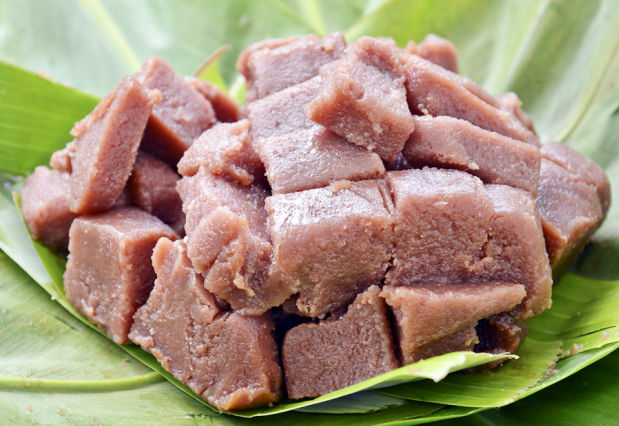
Photo courtesy of thegardenisland.com
Kūlolo is another favorite Hawaiian dessert made out of kalo, coconut milk, and sugar. It is then wrapped in ti leaves and baked in a standard oven, or traditionally in the ʻimu. Some refer to it as a pudding, but it has a texture more similar to fudge that’s also a bit grainier and stickier.
Kūlolo is often considered as a delicacy, at least if you’re trying to find quality kūlolo. It’s widely known among the islands that the best kūlolo comes from Kauaʻi, so if you are planning to visit Kauaʻi in the future, make sure to pick up a block or two of this highly sought-after treat.
There are many more traditional Hawaiian dishes that exist, but these are the most popular and the most common foods eaten by locals here in Hawaiʻi. Now you can rid your mind of the idea that placing a pineapple on top of something makes it a Hawaiian dish. It doesn’t.




